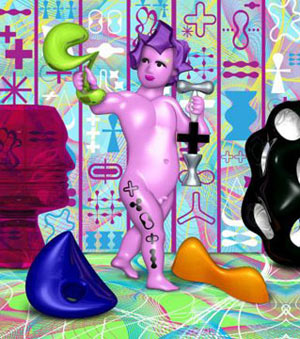
If you want to keep track of modern Danish art and design, Forårsudstillingen at Kunsthal Charlottenborg in Copenhagen is a pivotal point of departure. Yesterday was the final day of the annual censored exhibition, where artists like Per Kirkeby and Olafur Eliasson once had their debut, and I went there to catch a last glimpse of the exhibition’s proposition as to what the Scandinavian art scene will look like in the years to come. In its 151 year-history, Forårsudstillingen obviously draws on a number of traditions and codes of practice; however, a new and substantial initiative has been introduced this year, triggering critics to designate it a rebirth and a mall-like ornamentation. The 2008 exhibition has been curated much in line with the direction of the art scene in general, where hierarchies between different art directions are loosened, juxtaposed, and discussed.
Chief curator is the internationally acclaimed, New York-based designer Karim Rashid, who is responsible for the overall design and title of the exhibition, 21. With this title, Rashid lets the exhibition leap into the twenty-first century, where the boundaries between art and design become increasingly vague. Therefore, this year’s exhibition offers fashion, graphic design, and sound art aside from the more traditional genres of architecture and visual arts—all indicating renewal and a relation to our current social, political, spiritual, and technological development. Karim Rashid’s own aesthetic expression is present throughout the exhibition, not only in the selection and composition of the works, but also in the separate works that have been placed on walls covered with his colorful, digitally designed wallpapers, manifesting the unity of the exhibition as a whole.
Design and handicrafts aren’t exactly my cup of tea and many pieces, such as the ceramics and textiles, are pretty but a little boring. The exhibition does, however, demonstrate talent and showcases interesting works. Examples are Laura Baruël’s dress sculptures, Entrance, which revolves around the idea of primitive man’s basic need for protection of the body and the ensuing desire to express oneself through bodily ornamentation; Janni-Mai Larsen’s Inferno, a cubicled miniature inferno full of bits and pieces in girly colors, exploring the reinvention of sculptural montage—a piece, which sends references to the New Museum’s exhibition Unmonumental, which opened last year; and Vilsbøl de Arce, who have made a beautiful performative avant-garde dance video with a simple and evocative audio and equally interesting costumes and choreography. Most successful is City of the (Re)oriented by architects Ben Clement and Sebastian de la Cour, who have build a future cityscape with sticks, dirt, and decay, thereby commenting on social, political, technological, and artistic conditions in modern society.
“We have attempted to form a city which is not controlled by modern technology and all the tools you utilize when planning cities. This city has simply evolved on its own conditions as a city in perpetual transformation, and exactly because you can keep on adding, it ended up being a question on when to stop. It was decided by the day we had to hand in the installation to the exhibition,” say the art/architecture couple (my own translation). Coupling art and design has always been problematic, as there is a tendency either to transform art into pretty objects or to give a deeper meaning to pretty design items, which were only meant to be commodities. But overall, the exhibition was good and the design theme a legitimate choice in accordance with modern trends. However, due to the occasionally unimportant pieces of pretty art or design, I frequently felt like I was walking around Ikea rather than in a leading institutional art museum.
10 of the pieces will be on view at Politikens Forhal, Copenhagen, from July 24 until August 24.